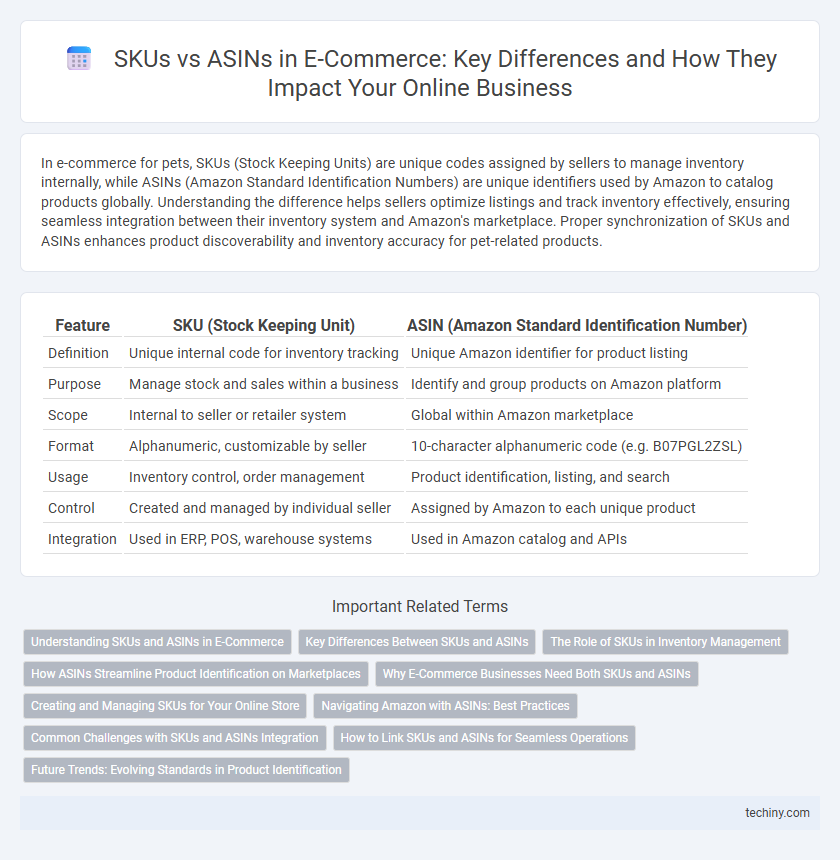In e-commerce for pets, SKUs (Stock Keeping Units) are unique codes assigned by sellers to manage inventory internally, while ASINs (Amazon Standard Identification Numbers) are unique identifiers used by Amazon to catalog products globally. Understanding the difference helps sellers optimize listings and track inventory effectively, ensuring seamless integration between their inventory system and Amazon's marketplace. Proper synchronization of SKUs and ASINs enhances product discoverability and inventory accuracy for pet-related products.
Table of Comparison
| Feature | SKU (Stock Keeping Unit) | ASIN (Amazon Standard Identification Number) |
|---|---|---|
| Definition | Unique internal code for inventory tracking | Unique Amazon identifier for product listing |
| Purpose | Manage stock and sales within a business | Identify and group products on Amazon platform |
| Scope | Internal to seller or retailer system | Global within Amazon marketplace |
| Format | Alphanumeric, customizable by seller | 10-character alphanumeric code (e.g. B07PGL2ZSL) |
| Usage | Inventory control, order management | Product identification, listing, and search |
| Control | Created and managed by individual seller | Assigned by Amazon to each unique product |
| Integration | Used in ERP, POS, warehouse systems | Used in Amazon catalog and APIs |
Understanding SKUs and ASINs in E-Commerce
SKUs (Stock Keeping Units) and ASINs (Amazon Standard Identification Numbers) are essential identifiers in e-commerce inventory management and product listings. SKUs are unique codes created by sellers to track inventory internally across multiple sales channels, while ASINs are unique product identifiers assigned by Amazon to catalog and distinguish products within its marketplace. Efficient use of SKUs streamlines warehouse operations and order fulfillment, whereas correct ASIN usage ensures accurate product visibility and searchability on Amazon's platform.
Key Differences Between SKUs and ASINs
SKUs (Stock Keeping Units) are unique alphanumeric codes created by sellers to track inventory internally, while ASINs (Amazon Standard Identification Numbers) are unique identifiers assigned by Amazon to each product listed on its platform. SKUs offer flexibility for customization according to a seller's inventory system, whereas ASINs provide a universal reference that simplifies product identification and comparison across Amazon's marketplace. Understanding these distinctions helps optimize inventory management and improves listing accuracy in e-commerce operations.
The Role of SKUs in Inventory Management
Stock Keeping Units (SKUs) are unique alphanumeric codes assigned by retailers to track and manage inventory efficiently across warehouses and sales channels. Unlike Amazon Standard Identification Numbers (ASINs), which identify products on Amazon's platform, SKUs provide detailed internal data on product variations such as size, color, and supplier, enabling precise stock control and reorder accuracy. Effective SKU management reduces stockouts and overstock situations, optimizing inventory turnover and enhancing overall supply chain performance.
How ASINs Streamline Product Identification on Marketplaces
ASINs streamline product identification on e-commerce marketplaces by providing a unique identifier for each product, simplifying catalog management and searchability. Unlike SKUs, which are merchant-specific codes, ASINs are standardized across platforms like Amazon, enabling consistent product matching and reducing listing errors. This uniformity enhances inventory tracking, improves customer experience, and supports efficient marketplace operations.
Why E-Commerce Businesses Need Both SKUs and ASINs
E-commerce businesses rely on SKUs (Stock Keeping Units) to internally track and manage inventory variations such as size, color, and style, enabling precise stock control and order fulfillment. ASINs (Amazon Standard Identification Numbers) serve as unique product identifiers within the Amazon marketplace, facilitating accurate product listings, searchability, and sales analysis. Utilizing both SKUs and ASINs ensures streamlined inventory management and optimized product visibility across multiple sales channels.
Creating and Managing SKUs for Your Online Store
Creating and managing SKUs (Stock Keeping Units) for your online store enables precise inventory tracking and efficient product categorization, directly impacting sales performance and customer satisfaction. Unlike ASINs, which are Amazon-specific identifiers, SKUs are customizable codes that reflect your unique product attributes such as size, color, and style, facilitating better supply chain management. Implement SKU generation best practices, including consistent formatting and integration with inventory management software, to streamline operations and enhance data accuracy across sales channels.
Navigating Amazon with ASINs: Best Practices
Effectively navigating Amazon requires understanding the unique role of ASINs (Amazon Standard Identification Numbers) compared to traditional SKUs (Stock Keeping Units). ASINs serve as universal product identifiers within Amazon's ecosystem, streamlining searchability and inventory management across diverse sellers. Leveraging optimized ASINs enhances product visibility, boosts listing accuracy, and improves sales performance on Amazon's platform.
Common Challenges with SKUs and ASINs Integration
Managing SKUs and ASINs integration often presents challenges like data inconsistency, resulting in inventory mismatches and order fulfillment errors. Synchronizing SKU identifiers with Amazon's ASINs requires precise mapping to prevent listing duplication and ensure accurate product representation. Businesses must implement robust systems to streamline integration, reduce errors, and maintain seamless e-commerce operations across platforms.
How to Link SKUs and ASINs for Seamless Operations
Linking SKUs and ASINs enables streamlined inventory management and accurate product identification across multiple sales channels in e-commerce. By mapping unique SKUs to their corresponding ASINs in your database, businesses ensure consistent product tracking, reduce errors, and improve order fulfillment efficiency. Integrating SKU and ASIN data through automated synchronization tools enhances seamless operations and enables real-time stock updates and analytics.
Future Trends: Evolving Standards in Product Identification
Emerging e-commerce platforms are increasingly integrating SKU (Stock Keeping Unit) and ASIN (Amazon Standard Identification Number) systems to enhance inventory accuracy and streamline product tracking. Future trends indicate a shift toward unified, AI-driven identification standards combining SKU customization with the global reach of ASIN databases for better scalability and real-time analytics. Blockchain technology is also being explored to secure and verify product identities, promising improved transparency and trust across supply chains.
SKUs vs ASINs Infographic

 techiny.com
techiny.com